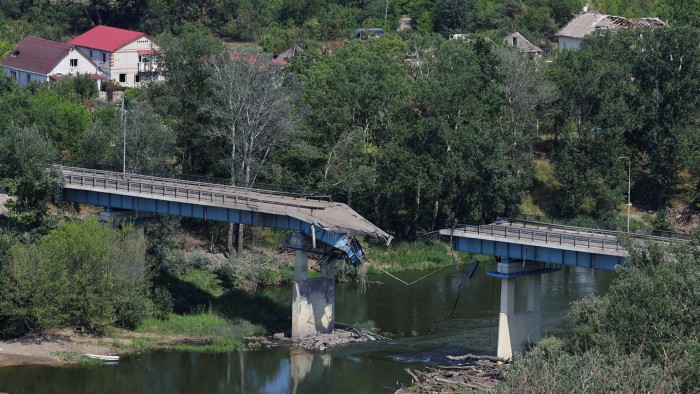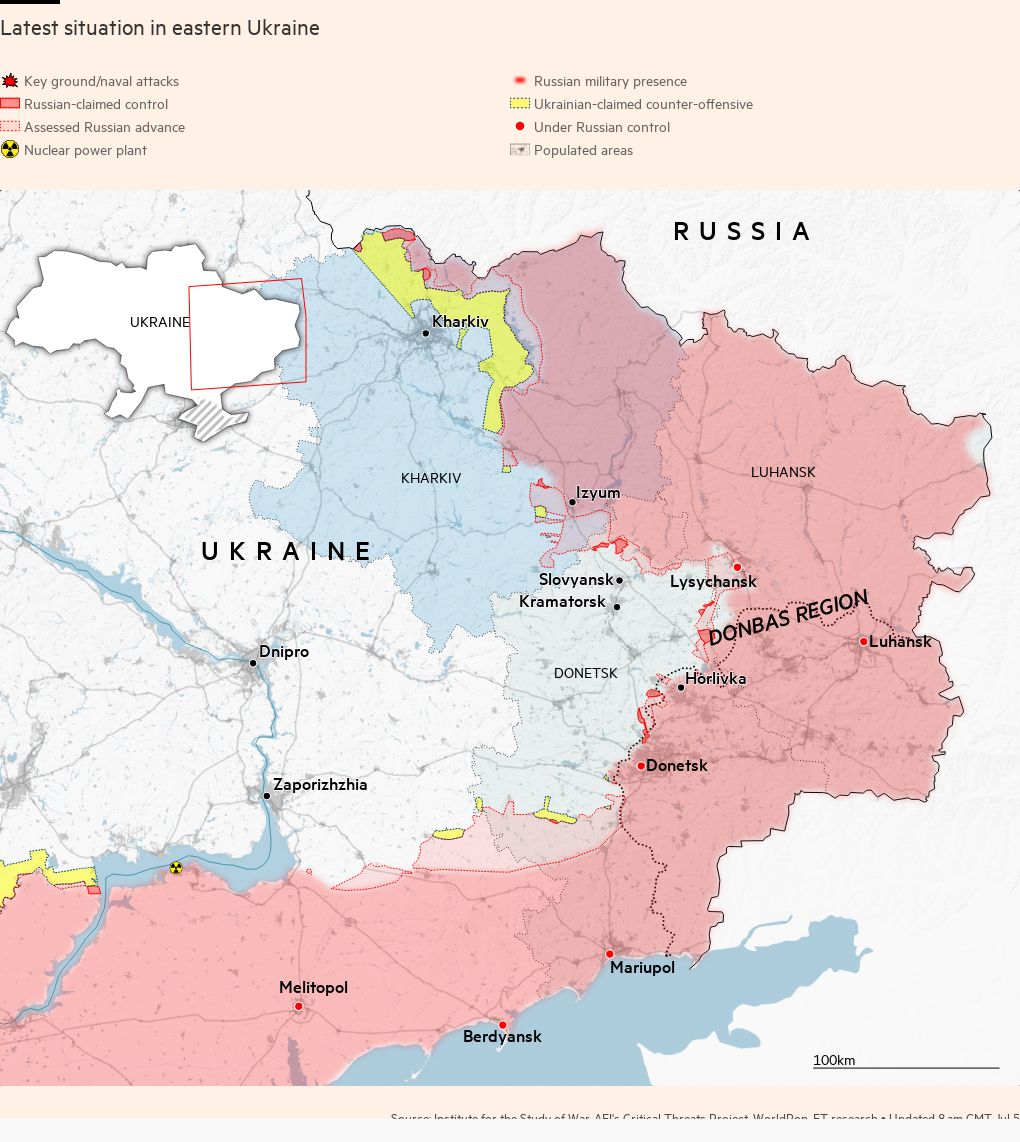Military briefing: how close is Russia to taking Donbas after the fall of Luhansk?

Simply sign up to the War in Ukraine myFT Digest -- delivered directly to your inbox.
Russia’s capture of the eastern Ukrainian city of Lysychansk, triggering the fall of the entire Luhansk province, was hailed as a victory by Vladimir Putin. But it is a symbolic more than a strategic one, say military experts.
The Russian president is still a long way from his objective of “liberating” the whole of the Donbas region, of which Luhansk is one half. On Monday he ordered his forces to press on into Donetsk province, the other half of Donbas, where the Ukrainians still control the cities of Slovyansk, Kramatorsk and Bakhmut with tens of thousands of troops.
Capturing the entire Donetsk region would require Russian forces to advance towards these heavily fortified cities 50km to 70km west of Lysychansk, and about the same again to reach the administrative border.
Despite Putin’s instruction to carry on, analysts and Ukrainian advisers say the war is likely to enter a new phase in which Kyiv’s troops try to use advanced weaponry freshly supplied by the west to cut Russian supply lines and destroy ammunition stocks and rear bases rather than cling on to territory.
The capture of all of Luhansk was a significant advance in Putin’s Donbas campaign and demonstrates that Russia’s military machine — grinding its way forward through intensive artillery bombardment — still has momentum, despite heavy losses. Lysychansk fell more quickly than some Ukrainian military advisers expected.
But the Kremlin’s aim when it relaunched its offensive in the Donbas region in mid-April was to surround and kill or capture tens of thousands of Ukrainian troops in the so-called Joint Forces Operation, dealing a perhaps fatal blow to the country’s war effort.
Not only does that remain a distant prospect but Russian troops have also failed to meet their scaled-back objectives of encircling Ukrainian forces in smaller “cauldrons” on the way.
“The enemy wanted not only to capture Donetsk and Luhansk regions in their administrative borders but to do it through a cauldron of Ukrainian forces . . . Their aim was [to] encircle and destroy our grouping there,” said retired lieutenant general Ihor Romanenko, a former deputy head of Ukraine’s general staff.
“We conducted operations in Severodonetsk and Lysychansk to the point where we could degrade their military might, but after they amassed forces far exceeding ours, it was necessary to withdraw our forces to avoid the cauldron.”
The bulk of Luhansk territory seized by Russia was taken soon after the invasion began in February, said Oleksandr V Danylyuk, head of the Kyiv-based Centre for Defence Reforms, a think-tank. But they struggled to take the last fifth, which was properly contested by Kyiv’s forces.
Oleksiy Arestovych, an adviser to President Volodymyr Zelenskyy, said Ukraine had succeeded in slowing down the Russian advance, despite incurring heavy losses of up to 200 deaths a day.
“The main tasks were: to pin down the main enemy forces; inflict losses on them; buy time for the supply of western weapons and improve the second line of defence; to create conditions for our offensive operations in other sectors of the front,” Arestovych said.
As Russian forces edge further west they are likely to encounter even stiffer resistance. Kramatorsk and Slovyansk were well defended after eight years of fortifications by Ukrainian forces, Danylyuk said. Russia’s aim will be to come within artillery range and then bombard Ukrainian positions.
Oleksiy Melnyk, a former Ukrainian Air Force officer now at the Razumkov Centre think-tank in Kyiv, said not even heavy fortifications would withstand a Russian artillery barrage and aerial bombardment. Russian guns have been firing tens of thousands of shells a day in Luhansk.
To break or at least slow Russia’s artillery steamroller, Ukraine now needed to target Russian supply lines using long-range weapons, especially US-supplied multiple-launch rocket systems, known as Himars, said Melnyk. Only four have so far been deployed to the battlefield, but with a 70km range and pinpoint accuracy they are being used to great effect.
A Ukrainian rocket attack severely damaged a big Russian air base near the occupied southern city of Melitopol on Sunday, well beyond the normal range of Kyiv’s artillery. Ukraine also struck Russian arms depots in Donetsk province.
Kyiv needs many more Himars to turn the tide of the war.
“If Ukraine has more capabilities to destroy ground supply lines and ammunition depots and deliver strikes to destroy artillery positions, Russia will have to adjust their plans or change them significantly as before,” said Melnyk.
As well as a shortage of artillery ammunition, Ukraine has multiple other weaknesses, including a lack of skilled infantry and armoured vehicles to conduct offensive operations, a shortage of secure radio equipment and an inability to detect and take out Russian electronic warfare capabilities, according to a report by the Royal United Services Institute in London.
Russia is also suffering from manpower shortages and depleted stocks of modern armour, leaving it dependent on its vastly superior artillery firepower, according to western and Ukrainian analysts.
Putin’s instruction to his forces in Luhansk to “rest” while others join the battle was seen by Ukrainian analysts as a tacit admission of the heavy losses they have suffered as well as a possible need to bolster artillery supplies.
Meanwhile, Ukrainian counter-attacks towards the occupied southern city of Kherson at the mouth of the Dnipro river, are putting pressure on Russian forces.
Although a Ukrainian assault on the city itself seems unlikely, given the risk of civilian casualties, Ukraine could try to encircle Russian troops in pockets along the right bank of the river.
“The problem for Russia is that they do not have enough forces to secure both directions [south and east],” said Mykhailo Samus, director of the New Geopolitics Research Network, who spent 12 years in the Ukrainian armed forces.
“The Ukrainian side will demonstrate its intention to play in both directions. For Ukraine, the southern front is more important for now because of the sea and port access for exports.”

Comments